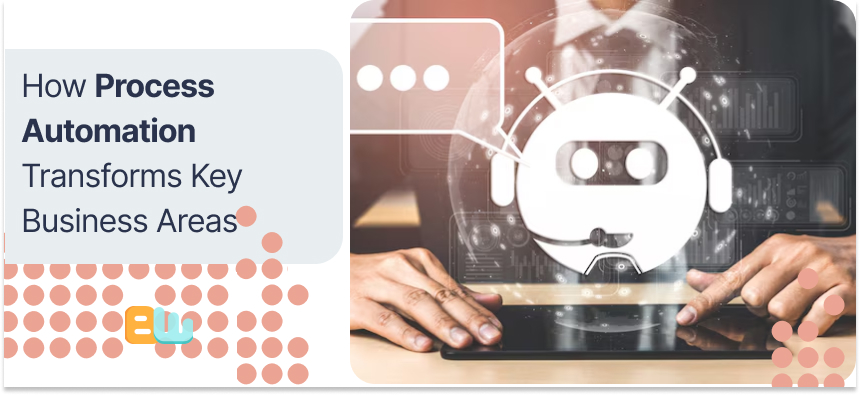
In today’s world, where everything moves quickly and relies heavily on technology, making things run smoothly in business is more crucial than ever. Thanks to robotic process automation (RPA), companies can speed up their work by automating jobs that are done repeatedly but don’t need someone to think them through or make decisions. This means using bots for stuff like typing, clicking around, and entering data so employees can spend time on tasks that add more value.
With the help of bots in process automation, businesses see a lot of good changes. For starters, it makes operations run smoother by organizing how workflows and cutting down mistakes made when things are done manually. It also helps save money because it lets people do less routine work, which means resources can be used better elsewhere. Plus, having bots handle repetitive tasks reduces errors ensuring information stays correct and safe, raising the quality of what’s produced, and lowering risks linked with entering data by hand.
This blog will dive deeper into how using bots for automating processes brings advantages, looking at ways it could change major parts within a company while touching upon hurdles some might face along this journey.
Exploring the Advantages of Process Automation Through Bots

Using bots for process automation brings many benefits to companies. With it, things get done faster and more smoothly across different parts of the business, saving money on everyday expenses. It also cuts down on mistakes people might make, makes things go quicker, and helps keep everything in line with rules and safe from risks.
Enhancing Efficiency Across Operations
Process automation with bots improves efficiency across operations by streamlining workflows and eliminating manual errors. Bots can handle high-volume, repetitive tasks that don’t require analytical skills, allowing employees to focus on more strategic and value-added work. By automating these tasks, businesses can significantly reduce the time and effort needed to complete them. This leads to faster turnaround times, increased productivity, and improved customer satisfaction.
Reducing Operational Costs
Process automation with bots can significantly reduce operational costs for businesses. By automating high-volume, repetitive tasks, companies can optimize resource allocation and reduce the need for human intervention. This leads to cost savings by reducing the number of hours required to complete these tasks and minimizing the risk of errors and rework. Additionally, process automation eliminates the need for manual data entry and processing, reducing administrative costs and improving operational efficiency.
Minimizing Human Errors
Human errors can have significant consequences for businesses, ranging from financial losses to reputational damage. Process automation with bots minimizes the risk of human errors by eliminating the need for manual data entry and processing. Bots follow predefined decision rules, ensuring accuracy and consistency in performing tasks. By automating repetitive tasks, process automation reduces the reliance on human intervention, minimizing the potential for errors and improving data integrity. This not only enhances the quality of work but also increases operational efficiency.
Boosting Productivity in Routine Tasks
Using bots to automate routine tasks helps businesses do more by letting their employees focus on the bigger picture. With automation, all those repetitive jobs get done faster and better, which means everyone can concentrate on work that adds more value. This makes things run smoother and boosts the amount that gets done. Plus, when folks aren’t stuck doing boring tasks day in and day out, they’re happier and more into their jobs because they get to tackle cooler projects that challenge them a bit more.
Ensuring Compliance and Security
Process automation with bots is crucial in ensuring compliance and security for businesses. Businesses can implement standardized workflows and enforce compliance with regulatory requirements by automating processes. This reduces the risk of non-compliance and potential penalties. Furthermore, process automation allows businesses to handle sensitive data securely by limiting access to authorized personnel and implementing robust data security measures. Bots follow predefined decision rules, ensuring consistent and compliant handling of sensitive data.
How Process Automation Transforms Key Business Areas

Process automation can really change the game for important parts of a business by making things run smoother, getting more work done faster, and boosting how well different tasks are performed. By using automation to take care of the boring stuff that people usually have to do repeatedly, companies can make better use of their resources. This lets employees spend time on bigger projects that add more value. Not only does this help with getting more done in less time and cutting costs, but it also encourages new ideas and growth. In what’s coming up next, we’ll dive into how process automation is shaking things up in areas like HR processes, managing customer relationships, keeping supply chains moving smoothly, and handling financial reports.
Transforming HR Processes
HR processes are critical components of any organization, and process automation can significantly transform them. Businesses can streamline HR workflows, reduce administrative burdens, and improve overall efficiency by automating tasks such as employee onboarding, leave management, and performance reviews. This saves time and resources and enhances the employee experience by eliminating manual processes and reducing the number of errors.
Innovating Customer Relationship Management
Customer relationship management (CRM) is vital for businesses to build and maintain strong customer relationships. Process automation can transform CRM by automating customer data entry, lead management, and customer support tasks. By automating these tasks, companies can streamline their CRM processes, improve response times, and enhance overall customer satisfaction. For example, process automation can automatically capture and update customer data in CRM systems, ensuring data accuracy and eliminating the need for manual data entry.
Optimizing Supply Chain Operations
Supply chain operations play a crucial role in businesses’ success, and process automation can optimize these operations. Businesses can streamline their supply chain processes, reduce lead times, and improve overall efficiency by automating tasks such as inventory management, order processing, and logistics coordination. For example, process automation can automatically track inventory levels, generate purchase orders, and coordinate shipments, ensuring timely and accurate delivery of goods.
Revolutionizing Financial Reporting
Financial reporting is critical to business operations, and process automation can revolutionize this area. Businesses can streamline their financial reporting processes, reduce manual errors, and improve data accuracy by automating tasks such as data extraction, report generation, and data analysis. For example, process automation can automatically extract financial data from various sources and consolidate it into standardized reports, eliminating the need for manual data entry and reducing the risk of errors.
Overcoming Challenges in Process Automation

Process automation can really help businesses out, but it can be challenging to get right. There are a few bumps in the road that companies might run into when they’re trying to put process automation into place. In this chat, we’ll look at some common problems and discuss ways to fix them. For starters, figuring out which processes should be automated and mapping them correctly is a big deal. Then there’s the challenge of dealing with changes – both for people working there and for the systems themselves. And on top of all that, ensuring everything works together smoothly after you’ve brought in new automation technologies is key.
Identifying and Mapping Suitable Processes
One key challenge in process automation is identifying and mapping suitable processes for automation. Not all methods are ideal for automation, and assessing the feasibility and potential benefits of automating a process is essential. Organizations need to evaluate the complexity of the process, the volume of tasks involved, and the possible impact on overall efficiency and productivity.
Managing Change Within Organizations
Change is bound to happen when bots and automation are added to the mix. Even though RPA (that’s short for robotic process automation) brings a lot of good stuff to the table, some folks might worry about losing their jobs or feel uneasy about all this new tech. To make sure everything goes smoothly, it’s super important for companies to keep everyone in the loop and be totally open from start to finish.
Ensuring Bot and Human Workforce Collaboration
To make process automation work well, it’s important for bots and people to team up the right way. Bots are good at doing the same thing repeatedly, but we need humans for their great ideas, understanding of feelings, and solving tricky problems. Companies can get exceptional results when both sides use what they’re best at.
Working together with bots can look different depending on what needs to be done. For instance, bots can take care of boring jobs that consume a lot of time so that people have more space to think about bigger issues or develop new ideas. This makes workers happier because they’re not stuck doing dull tasks all day; plus, it helps everyone do their jobs better and faster.
Keeping Up with Technological Advances
In the world of process automation, things are always bots, and people need to team up. Companies need to keep an eye on these updates and use them to improve their automation.
At the heart of all this change are machine learning and AI. Machine learning lets robots get smarter over time by learning from data. With AI, automation can do more demanding jobs like understanding human language and making decisions.
By embracing these new tech advancements, companies can do some cool stuff, such as more significant automation. They can automate tasks that used to require a person’s touch, which means they can work more efficiently and make fewer mistakes.
Conclusion
Using bots for process automation brings a lot of good stuff to the table, like making things run smoother and faster, cutting costs, and making fewer mistakes. By making their operations more efficient and beefing up security, companies can really change the game in areas such as HR tasks, dealing with customers better, managing how goods move from A to B, and keeping track of finances accurately. It’s super important to get past hurdles like figuring out which processes can be automated well and getting people and bots to work together nicely if you want this whole thing to work out great. Staying up-to-date with new tech is key for keeping this success going over time. Getting on board with using bots makes things run better, keeps your data safe, and meets rules that need following.
